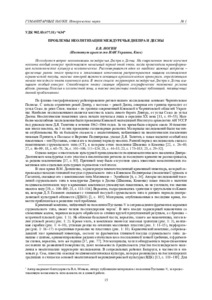Please use this identifier to cite or link to this item:
https://elib.psu.by/handle/123456789/1557Full metadata record
| DC Field | Value | Language |
|---|---|---|
| dc.contributor.author | Ногин, Е. В. | ru_RU |
| dc.date.accessioned | 2014-03-21T05:57:29Z | - |
| dc.date.available | 2014-03-21T05:57:29Z | - |
| dc.date.issued | 2014 | - |
| dc.identifier.citation | Вестник Полоцкого государственного университета. Серия A, Гуманитарные науки: научно-теоретический журнал. – Новополоцк: ПГУ, 2014. - № 1. - С. 15-20. | ru_RU |
| dc.identifier.issn | 2070-1608 | - |
| dc.identifier.uri | https://elib.psu.by/handle/123456789/1557 | - |
| dc.description | The Problems of the Dnieper and Desna Rivers Neolitization / E.V. Nogin (Institut Arheologii Nan Ukrainy, Kiev). Е.В. Ногин (Институт Археологии Нан Украины, Киев) | en |
| dc.description.abstract | Исследуется вопрос неолитизации междуречья Днепра и Десны. На современном этапе изучения неолита особый интерес представляет начальный период этой эпохи, когда происходила трансформация мезолитических культур в неолитические. Рассматривается один из наиболее важных вопросов – временные рамки этого процесса и локализация источников распространения навыков изготовления керамической посуды, наличие которой является основным археологическим критерием, определяющим начало последнего этапа каменного века. В этом смысле территория междуречья Днепра и Десны вызывает особый интерес. Способствует этому главным образом географическое положение региона вблизи границы Полесья и лесостепной зоны, а также отсутствие отдельных публикаций, посвященных данной проблематике. = The author investigated the question of the Dnieper and Desna rivers neolitization. At the present research stage, the initial period of this era associated with a transformation of the Mesolithic cultures into Neolithic ones causes a great interest. The author considered one of the most important issues – both the period for this process and localization of the sources of ceramic tableware making skills dissemination. The presence of those sources is a major archaeological criterion for determining the start of the Stone Age last phase. In this sense, the territory between the Dnieper and Desna rivers causes a particular interest due to a geographical position of the discussed regions – near the boundary of Polessye and forest-steppe zone as well as the lack of publications on the discussed theme. | ru_RU |
| dc.language.iso | ru | ru_RU |
| dc.publisher | Полоцкий государственный университет | ru_RU |
| dc.relation.ispartof | Веснік Полацкага дзяржаўнага ўніверсітэта. Серыя А, Гуманітарныя навук | be_BE |
| dc.relation.ispartof | Herald of Polotsk State University Series A, Humanity sciences | en_EN |
| dc.relation.ispartof | Вестник Полоцкого государственного университета. Серия A, Гуманитарные науки | ru_RU |
| dc.relation.ispartofseries | Серия A, Гуманитарные науки;2014.- № 1 | - |
| dc.rights | open access | ru_RU |
| dc.subject | Исторические науки | ru_RU |
| dc.subject | неолит | ru_RU |
| dc.subject | каменный век | ru_RU |
| dc.subject | междуречье Днепра и Десны | ru_RU |
| dc.title | Проблемы неолитизации междуречья Днепра и Десны | ru_RU |
| dc.type | Article | ru_RU |
| dc.identifier.udc | УДК 902.03(477.51) “634” | ru_RU |
| Appears in Collections: | 2014, № 1 | |
Items in DSpace are protected by copyright, with all rights reserved, unless otherwise indicated.
